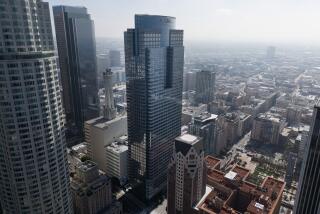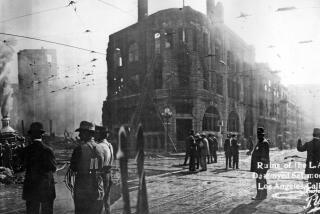TERROR IN OKLAHOMA CITY : Architect’s Job: Make It Bomb-Resistant
OKLAHOMA CITY — When James Loftis began designing a downtown office tower in the 1970s, the Vietnam War was being waged and the government feared protesters. His orders were clear: Make the building bomb-resistant.
Five days ago, the 53-year-old architect’s creation had become the scene of an unspeakable catastrophe. The cause: a home-brewed bomb.
The Alfred P. Murrah Federal Building, nine stories of glass and concrete, entered the annals of U.S. disasters at 9:04 a.m. on April 19, when thousands of pounds of explosives packed in a truck ripped away its north side.
Loftis pointed out that the government asked him to make the building bomb-resistant, not bombproof. It also asked that the building be energy efficient and have lots of space on the first floor.
Bombproof buildings, while possible, are impractical and their costs prohibitive, said Loftis, who has worked in Japan, Australia and Malaysia.
“The way you do it is have three or four feet of reinforced concrete. Many times you put them underground. . . . You go through a maze of doorways, there would be no windows,” he explained. “Who would want to live in it?”
Loftis also said that construction in that manner sends the wrong message.
“We just have to resolve we’re going to use whatever courage we have to continue life in normal fashion and not let these people intimidate us into burying ourselves in the ground and living with a bunker mentality,” he said.
After the blast Wednesday, Loftis rushed to the scene, buttonholed firefighters and helped, along with the building’s structural engineer and blueprints, to guide rescuers searching for survivors.
“I know the building inside and out,” Loftis said. “I know where the strengths can be and where the weaknesses can be.”
He said rescuers were concerned about the safety of stairwells; he assured them they were solid and could be used. In fact, he said the elevator shafts and fire stairs are sturdy enough to be resurrected and used again.
Loftis speculated that the vehicle bomb exploded from a parking space on the street at the east end of the building’s north side. He said damage might have been less devastating if the blast had occurred nearer the middle.
“The building would have absorbed the shock better if it were 40 to 50 feet closer to the center,” he said. “It would have allowed the strength of the building to resist equally.”
Rep. Ernest Istook Jr. (R-Okla.) estimated it would cost at least $28 million to replace the building. White House Chief of Staff Leon E. Panetta said President Clinton will approve the rebuilding.
The Murrah building opened in 1977 and is named after a judge.
More to Read
Sign up for Essential California
The most important California stories and recommendations in your inbox every morning.
You may occasionally receive promotional content from the Los Angeles Times.










